Comment extraire uniquement les points de retournement de bas de page extraits par l'indicateur zigzag ?
comme la comparaison
double K = iCustom(Symbol(),0,"zigzag",ExtDepth,ExtDeviation,ExtBackstep,0,i); if (K==Low[i] && K>0) //..low zigzag......
deVries,
Merci beaucoup pour votre réponse rapide. Voulez-vous dire simplement changer l'avant-dernier paramètre de iCustom à 0 ? J'ai déjà essayé de le faire et le résultat n'est pas du tout ce que je souhaitais... Pour rendre ma question plus claire, je vous montre les deux figures ci-dessous pour illustrer ma question....
Fig1. Des sommets non désirés sont affichés alors que je ne veux afficher que les sommets ! Je veux filtrer tous les hauts indésirables alors que je ne veux afficher que les bas.
FIg2. Les hauts désirés sont affichés sans aucun bas indésirable. C'est le résultat que je souhaite obtenir.
Ma question est donc la suivante : est-il possible d'afficher uniquement les points bas sans afficher les points A/B/C/D/E ? J'espère avoir répondu clairement à ma question......
Merci beaucoup pour votre réponse rapide....
//+------------------------------------------------------------------+ //| Zigzag2.mq4 | //| Copyright © 2005-2007, MetaQuotes Software Corp. | //| http://www.metaquotes.net/ | //+------------------------------------------------------------------+ #property copyright "Copyright © 2007, MetaQuotes Software Corp." #property link "http://www.metaquotes.net/" #property indicator_chart_window #property indicator_buffers 3 #property indicator_color1 Red #property indicator_color2 Magenta #property indicator_color3 LightSkyBlue //---- indicator parameters extern int ExtDepth=12; extern int ExtDeviation=5; extern int ExtBackstep=3; //---- indicator buffers double ZigzagBuffer[]; double HighMapBuffer[]; double LowMapBuffer[]; int level=3; // recounting's depth bool downloadhistory=false; //+------------------------------------------------------------------+ //| Custom indicator initialization function | //+------------------------------------------------------------------+ int init() { IndicatorBuffers(3); //---- drawing settings SetIndexStyle(0,DRAW_SECTION); SetIndexStyle(1,DRAW_SECTION); SetIndexStyle(2,DRAW_SECTION); //---- indicator buffers mapping SetIndexBuffer(0,ZigzagBuffer); SetIndexBuffer(1,HighMapBuffer); SetIndexBuffer(2,LowMapBuffer); SetIndexEmptyValue(0,0.0); SetIndexEmptyValue(1,0.0); SetIndexEmptyValue(2,0.0); //---- indicator short name IndicatorShortName("ZigZag("+ExtDepth+","+ExtDeviation+","+ExtBackstep+")"); //---- initialization done return(0); } //+------------------------------------------------------------------+ //| | //+------------------------------------------------------------------+ int start() { int i, counted_bars = IndicatorCounted(); int limit,counterZ,whatlookfor; int shift,back,lasthighpos,lastlowpos; double val,res; double curlow,curhigh,lasthigh,lastlow; if (counted_bars==0 && downloadhistory) // history was downloaded { ArrayInitialize(ZigzagBuffer,0.0); ArrayInitialize(HighMapBuffer,0.0); ArrayInitialize(LowMapBuffer,0.0); } if (counted_bars==0) { limit=Bars-ExtDepth; downloadhistory=true; } if (counted_bars>0) { while (counterZ<level && i<100) { res=ZigzagBuffer[i]; if (res!=0) counterZ++; i++; } i--; limit=i; if (LowMapBuffer[i]!=0) { curlow=LowMapBuffer[i]; whatlookfor=1; } else { curhigh=HighMapBuffer[i]; whatlookfor=-1; } for (i=limit-1;i>=0;i--) { ZigzagBuffer[i]=0.0; LowMapBuffer[i]=0.0; HighMapBuffer[i]=0.0; } } for(shift=limit; shift>=0; shift--) { val=Low[iLowest(NULL,0,MODE_LOW,ExtDepth,shift)]; if(val==lastlow) val=0.0; else { lastlow=val; if((Low[shift]-val)>(ExtDeviation*Point)) val=0.0; else { for(back=1; back<=ExtBackstep; back++) { res=LowMapBuffer[shift+back]; if((res!=0)&&(res>val)) LowMapBuffer[shift+back]=0.0; } } } if (Low[shift]==val) LowMapBuffer[shift]=val; else LowMapBuffer[shift]=0.0; //--- high val=High[iHighest(NULL,0,MODE_HIGH,ExtDepth,shift)]; if(val==lasthigh) val=0.0; else { lasthigh=val; if((val-High[shift])>(ExtDeviation*Point)) val=0.0; else { for(back=1; back<=ExtBackstep; back++) { res=HighMapBuffer[shift+back]; if((res!=0)&&(res<val)) HighMapBuffer[shift+back]=0.0; } } } if (High[shift]==val) HighMapBuffer[shift]=val; else HighMapBuffer[shift]=0.0; } // final cutting if (whatlookfor==0) { lastlow=0; lasthigh=0; } else { lastlow=curlow; lasthigh=curhigh; } for (shift=limit;shift>=0;shift--) { res=0.0; switch(whatlookfor) { case 0: // look for peak or lawn if (lastlow==0 && lasthigh==0) { if (HighMapBuffer[shift]!=0) { lasthigh=High[shift]; lasthighpos=shift; whatlookfor=-1; ZigzagBuffer[shift]=lasthigh; res=1; } if (LowMapBuffer[shift]!=0) { lastlow=Low[shift]; lastlowpos=shift; whatlookfor=1; ZigzagBuffer[shift]=lastlow; res=1; } } break; case 1: // look for peak if (LowMapBuffer[shift]!=0.0 && LowMapBuffer[shift]<lastlow && HighMapBuffer[shift]==0.0) { ZigzagBuffer[lastlowpos]=0.0; lastlowpos=shift; lastlow=LowMapBuffer[shift]; ZigzagBuffer[shift]=lastlow; res=1; } if (HighMapBuffer[shift]!=0.0 && LowMapBuffer[shift]==0.0) { lasthigh=HighMapBuffer[shift]; lasthighpos=shift; ZigzagBuffer[shift]=lasthigh; whatlookfor=-1; res=1; } break; case -1: // look for lawn if (HighMapBuffer[shift]!=0.0 && HighMapBuffer[shift]>lasthigh && LowMapBuffer[shift]==0.0) { ZigzagBuffer[lasthighpos]=0.0; lasthighpos=shift; lasthigh=HighMapBuffer[shift]; ZigzagBuffer[shift]=lasthigh; } if (LowMapBuffer[shift]!=0.0 && HighMapBuffer[shift]==0.0) { lastlow=LowMapBuffer[shift]; lastlowpos=shift; ZigzagBuffer[shift]=lastlow; whatlookfor=1; } break; default: return; } } return(0); } //+------------------------------------------------------------------+
Il était possible de ne montrer que le tampon zigzag.
le zigzag se repeint
voir le résultat de ceci
Voici ce que j'ai trouvé. Je n'ai pas vérifié les résultats de deVries ci-dessus [je faisais cela quand il a posté].
#property indicator_chart_window #property indicator_buffers 2 #property indicator_color1 Green #property indicator_width1 1 #property indicator_color2 Yellow #property indicator_width2 1 double Bottoms[]; double Toppers[]; int init() { IndicatorBuffers(2); SetIndexStyle(0,DRAW_SECTION); SetIndexBuffer(0,Bottoms); SetIndexEmptyValue(0,0.0); SetIndexStyle(1,DRAW_SECTION); SetIndexBuffer(1,Toppers); SetIndexEmptyValue(1,0.0); IndicatorShortName("zz show top & bottom"); return(0); } int deinit() { return(0); } int start() { int counted_bars=IndicatorCounted(); int limit=0; limit = Bars-counted_bars; for(int shift=limit-1;shift>=0;shift--) { int ExtDepth=12; int ExtDeviation=5; int ExtBackstep=3; int ZigzagBuffer=0; int HighMapBuffer=1; int LowMapBuffer=2; Bottoms[shift]=iCustom( Symbol(),0,"ZigZag", ExtDepth, ExtDeviation, ExtBackstep, LowMapBuffer, shift ); Toppers[shift]=iCustom( Symbol(),0,"ZigZag", ExtDepth, ExtDeviation, ExtBackstep, HighMapBuffer, shift ); if(Bottoms[shift]>0.1) Bottoms[shift]=Bottoms[shift]; if(Toppers[shift]>0.1) Toppers[shift]=Toppers[shift]; } return(0); }
Voici ce que j'ai trouvé. Je n'ai pas vérifié les résultats de deVries ci-dessus [je faisais cela quand il a posté].
#property indicator_chart_window #property indicator_buffers 3 #property indicator_color1 Red #property indicator_width1 3 #property indicator_color2 Green #property indicator_width2 3 #property indicator_color3 Yellow #property indicator_width3 3 //---- indicator parameters extern int ExtDepth=12; extern int ExtDeviation=5; extern int ExtBackstep=3; double ZigZag[]; double Bottoms[]; double Toppers[]; int init() { IndicatorBuffers(3); SetIndexStyle(0,DRAW_SECTION); SetIndexBuffer(0,ZigZag); SetIndexEmptyValue(0,0.0); SetIndexStyle(1,DRAW_SECTION); SetIndexBuffer(1,Bottoms); SetIndexEmptyValue(1,0.0); SetIndexStyle(2,DRAW_SECTION); SetIndexBuffer(2,Toppers); SetIndexEmptyValue(2,0.0); IndicatorShortName("zz show top & bottom"); return(0); } int deinit() { return(0); } int start() { int counted_bars=IndicatorCounted(); int limit=0; limit = Bars-counted_bars; for(int shift=limit-1;shift>=0;shift--) { ZigZag[shift]=iCustom( Symbol(),0,"ZigZag", ExtDepth, ExtDeviation, ExtBackstep, 0, shift ); if(ZigZag[shift]>0.1 && Low[shift]==ZigZag[shift]) Bottoms[shift]=ZigZag[shift]; if(ZigZag[shift]>0.1 && High[shift]==ZigZag[shift]) Toppers[shift]=ZigZag[shift]; } return(0); }
Cela donne le résultat suivant
maintenant les bas et les hauts correspondent tous avec le zigzag.
deVries:
Nice ubzen avec l'aide de votre code je suis venu à ce......Cela donne comme résultat
maintenant les bas et les hauts correspondent tous avec le zigzag
Bonjour deVries,
Merci beaucoup pour votre code. Si je veux savoir à quelle distance se trouve le Retracement de Fibonacci de la dernière jambe en zigzag, par rapport à la jambe en zigzag précédente. Comment faire ?
Je veux faire comme l'image, mais le code ci-dessous que j'ai essayé ne l'a pas fait ...
Merci,
jack
#property indicator_chart_window #property indicator_buffers 3 #property indicator_color1 Red #property indicator_width1 3 #property indicator_color2 Green #property indicator_width2 3 #property indicator_color3 Yellow #property indicator_width3 3 //---- indicator parameters extern int ExtDepth=12; extern int ExtDeviation=5; extern int ExtBackstep=3; double ZigZag[]; double Bottoms[]; double Toppers[]; double resBuffer[][]; //--- int init() { IndicatorBuffers(3); SetIndexStyle(0,DRAW_SECTION); SetIndexBuffer(0,ZigZag); SetIndexEmptyValue(0,0.0); SetIndexStyle(1,DRAW_SECTION); SetIndexBuffer(1,Bottoms); SetIndexEmptyValue(1,0.0); SetIndexStyle(2,DRAW_SECTION); SetIndexBuffer(2,Toppers); SetIndexEmptyValue(2,0.0); IndicatorShortName("zz show top & bottom"); return(0); } int deinit() { ObjectDelete("myFibo"); return(0); } int start() { int counted_bars=IndicatorCounted(); int limit=0; limit = Bars-counted_bars; int k=0, m=0; int candle1=0, candle2=0; double prc1=0, prc2=0; for(int shift=limit-1;shift>=0;shift--) { ZigZag[shift]=iCustom( Symbol(),0,"ZigZag", ExtDepth, ExtDeviation, ExtBackstep, 0, shift ); if(ZigZag[shift]>0.1 && Low[shift]==ZigZag[shift]) { Bottoms[shift]=ZigZag[shift]; resBuffer[k][0] = Bottoms[shift]; resBuffer[k][1] = shift; k++; } if(ZigZag[shift]>0.1 && High[shift]==ZigZag[shift]) { Toppers[shift]=ZigZag[shift]; resBuffer[k][0] = Toppers[shift]; resBuffer[k][1] = shift; k++; } } // ende for //--- for(m=k;m>=0;m--) { candle1 = resBuffer[m][1]; prc1 = resBuffer[m][0]; candle2 = resBuffer[m-1][1]; prc2 = resBuffer[m-1][0]; //--- ObjectDelete("myFibo"); ObjectCreate("myFibo", OBJ_FIBO, 0, Time[candle1], prc2, Time[candle2], prc1); } // ende for return(0); }
Bonjour deVries,
Merci beaucoup pour votre code. Si je veux savoir à quelle distance se trouve le Retracement de Fibonacci de la dernière jambe de zigzag, par rapport à la jambe de zigzag précédente. Comment faire ?
Merci,
jack
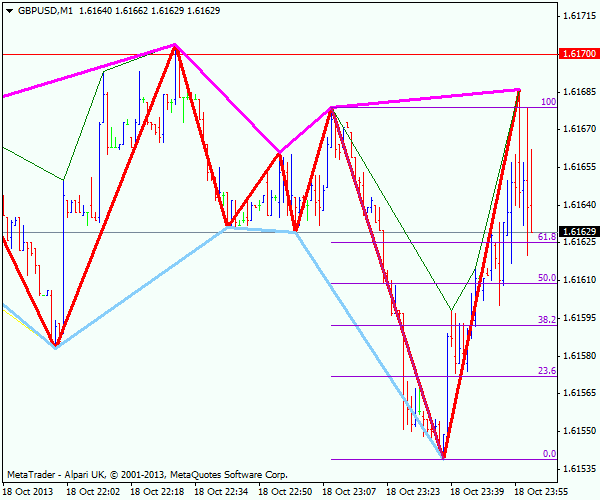
dessiner fibonacci de cette façon trouver les deux points avec l'indicateur zigzag iCustom
0.0 1.6154
100.0 1.6168
différence 0.0014
dernier sommet = 1.6169
différence avec 0.0 0.0015 en% 0.0015/0.0014 * 100% = 107% en distance + 0.0001
C'est ce que vous voulez dire ?
Bonjour deVries,
Merci. Oui, c'est comme l'image que vous avez envoyé. Mais je veux savoir comment le coder. Il doit calculer chaque jambe de zigzag précédente, puis dessiner le niveau de Fibonacci, afin que nous sachions jusqu'où va le zigzag actuel / dernier zigzag.
edit : j'ai envoyé le code sur le post précédent. Il ne dessine pas la ligne de Fibonacci ...
Merci
- Applications de trading gratuites
- Plus de 8 000 signaux à copier
- Actualités économiques pour explorer les marchés financiers
Vous acceptez la politique du site Web et les conditions d'utilisation


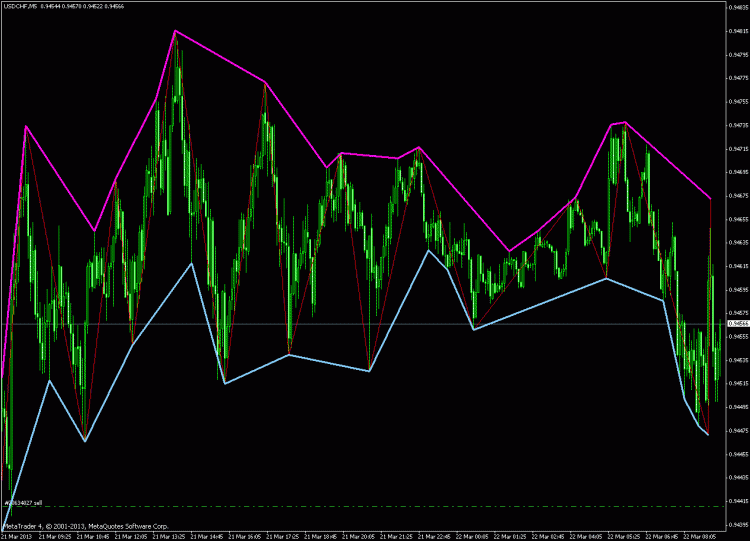
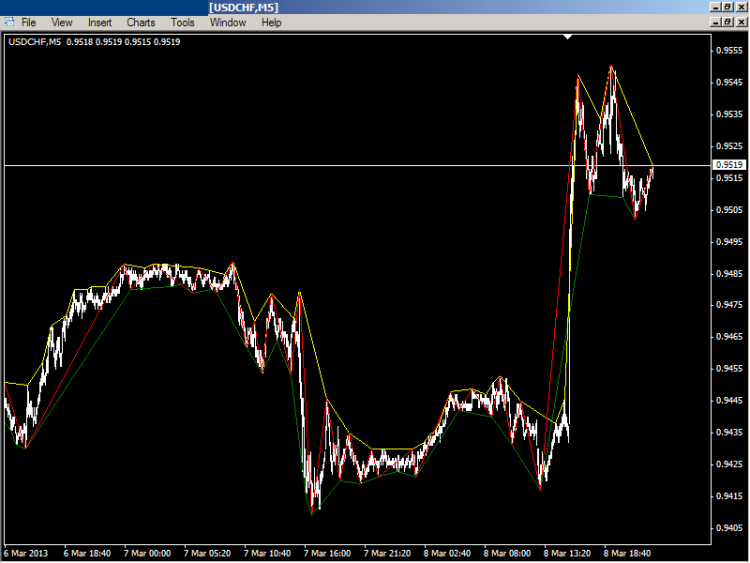
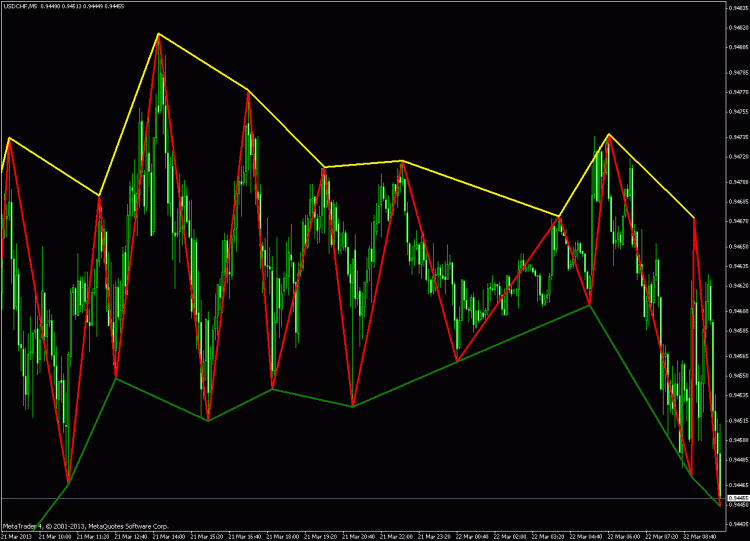
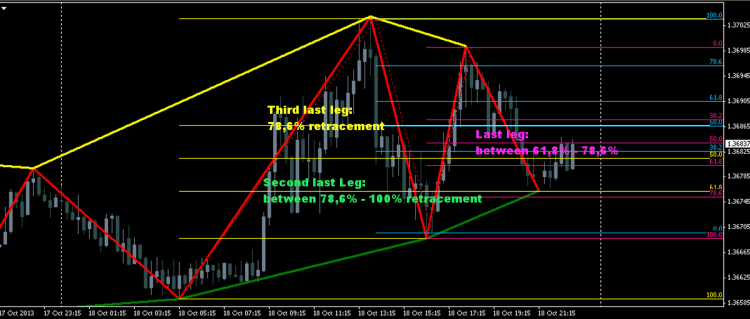
Cher tous, Comment modifier le code pour montrer seulement les bas du zigzag ?